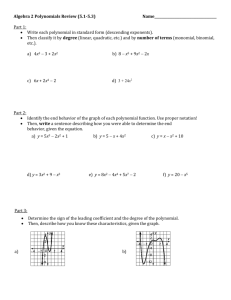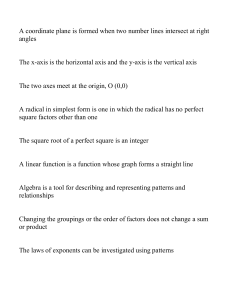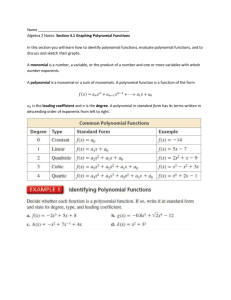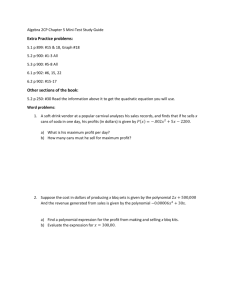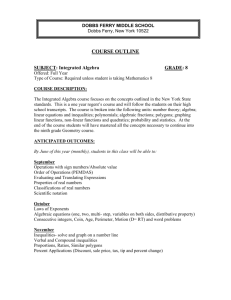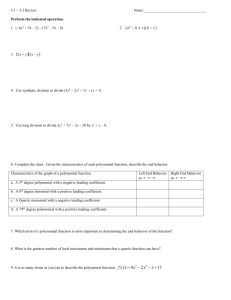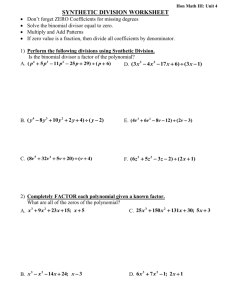Mathematics
advertisement
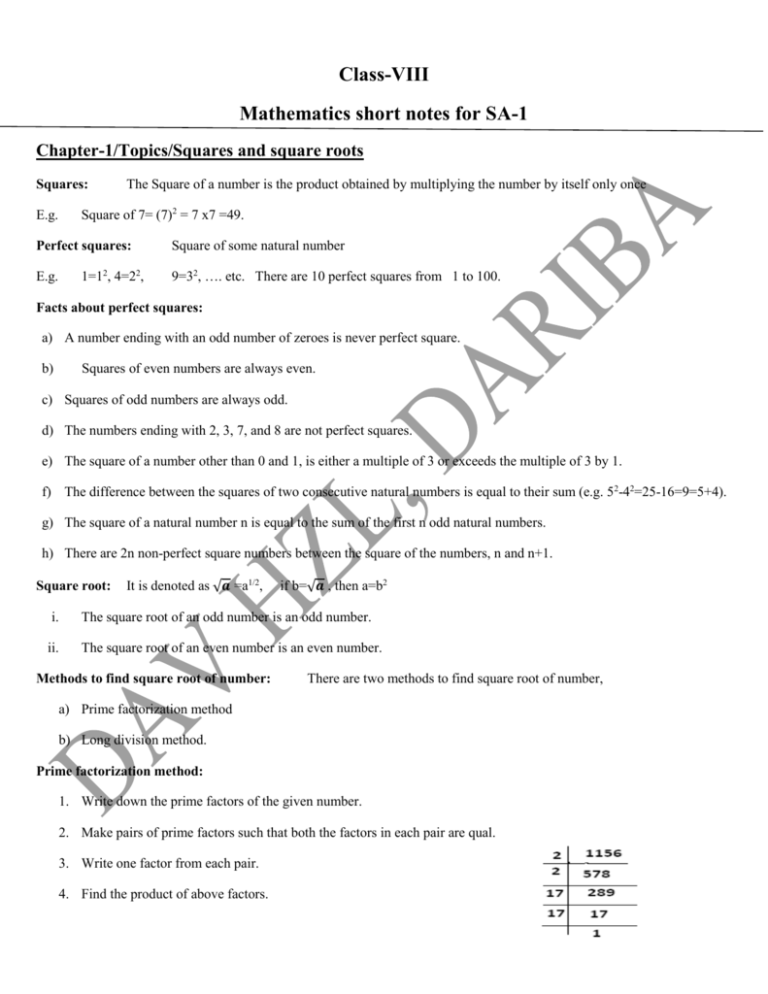
Class-VIII Mathematics short notes for SA-1 Chapter-1/Topics/Squares and square roots Squares: The Square of a number is the product obtained by multiplying the number by itself only once Square of 7= (7)2 = 7 x7 =49. E.g. Perfect squares: 1=12, 4=22, E.g. Square of some natural number 9=32, …. etc. There are 10 perfect squares from 1 to 100. Facts about perfect squares: a) A number ending with an odd number of zeroes is never perfect square. b) Squares of even numbers are always even. c) Squares of odd numbers are always odd. d) The numbers ending with 2, 3, 7, and 8 are not perfect squares. e) The square of a number other than 0 and 1, is either a multiple of 3 or exceeds the multiple of 3 by 1. f) The difference between the squares of two consecutive natural numbers is equal to their sum (e.g. 52-42=25-16=9=5+4). g) The square of a natural number n is equal to the sum of the first n odd natural numbers. h) There are 2n non-perfect square numbers between the square of the numbers, n and n+1. Square root: It is denoted as √𝒂 =a1/2, if b=√𝒂 , then a=b2 i. The square root of an odd number is an odd number. ii. The square root of an even number is an even number. Methods to find square root of number: There are two methods to find square root of number, a) Prime factorization method b) Long division method. Prime factorization method: 1. Write down the prime factors of the given number. 2. Make pairs of prime factors such that both the factors in each pair are qual. 3. Write one factor from each pair. 4. Find the product of above factors. 5. The product in the required square root. Example: find √𝟏𝟏𝟓𝟔 =√𝟐 × 𝟐 × 𝟏𝟕 × 𝟏𝟕 =2× 𝟏𝟕 = 𝟑𝟒 Long division method: 1. Mark of the digits in pairs starting with the unit digit. Each pair and remaining one digit is called period. 2. Think of the largest number whose square is either equal to or just less than the first period starting from left. This digit is the quotient as well as the divisor. 3. Put the quotient just below the first period. 4. Find the remainder. 5. Bring down the next pair of digits to the right of the remainder. 6. Double the current quotient and enter it as divisor with a blank on its right. 7. Guess a largest possible digit to fill the blank which also becomes the new digit in the quotient such that when the new digit is multiplied to the new divisor , the product is either less than or equal to the dividend. 8. Now, subtract the product of new divisor and the new digit from the new dividend. 9. If the remainder is zero, then we stop and the current quotient is the square root of the given number. If the remainder is non-zero then we continue from iv to ix. E.g. find √𝟏𝟏𝟓𝟔 by long division method. Square roots of numbers in decimal form: 1. Makes pair from the left. 2. Then, find square root as in the case of long division method. 3. Please the decimal point as soon as the integral part comes to an end. E.g. Find the square roots of 7.29, Extra questions: find square root of 3, 2, 5, and 7 up to three decimal figures. (Hint: after 3 put decimal then write 6 times 0 like 3.000000 similarly you can do2, 5, and 7 also then do the same process like previous example.) Chapter:2/ Topics/ Cubes and cube roots Cube: It is product of number which multiplied by itself three times itself and is read as the number raised to the power of 3 Example: 8x8x8=83=512, students must learn at least cube of 1 to 30 Properties of cubes: a. The cube of an even number is always even. b. The cube of an odd number is always odd. 𝟑 It is denoted as √ Cube roots: , If a is cube root of b, then b is the cube of a. 𝟑 a=√𝒃 implies that b=a3 Cube root by prime factorization method: Step 1: Resolve the given number into its prime factor. Step 2: Group the factors into triplets. Step 3: Take one factor out of each triplet Step 4: Multiply all the factors taken from the triplet and their product will be the required cube root. Example: Find the cube root of 216. 𝟑 𝟒𝟗𝟏𝟑 𝟑 𝟑 √𝟒𝟗𝟏𝟑 Cube root of rational number: √ 𝟐𝟏𝟔 = 𝟑 √𝟐𝟏𝟔 =𝟑 √𝟏𝟕×𝟏𝟕×𝟏𝟕 √𝟐×𝟐×𝟐×𝟑×𝟑×𝟑 𝟏𝟕 𝟏𝟕 =𝟐×𝟑 = 𝟔 Cube root of number through estimation: From this method we can find only perfect cubes number. a. Consider the number 13824 b. Start making the groups of three digits starting from the right most digit of numbers 13 824 c. First group is 824 and second group is 13. From the first group 824, take the digit from ones place, this is 4 which is ones digit of cube root of given number (43=64) 3 d. Now take the second group 13. We know that 8<13<27= 23<13<33, so √𝟏𝟑𝟖𝟐𝟒 =24. Chapter-4 /Topics / Direct and inverse variation Variation: If the values of two quantities are related in such a way that a change in one results in a corresponding change in other the two quantities are said to be in variation. Types of Variation: (i) Direct variation: 𝒙 that 𝒚 = 𝒌(constant) Two quantities x and y are said to be in direct if x and y increase or decrease together in such a way Example1: less cost) 𝟐𝟎 𝟓 Example 2: Direct variation (ii) Inverse variation Cost of 5 pencils is Rs. 20 and cost of such two pencils is Rs. 8(Here more pencil more price and less pencil = 𝟖 𝟐 =4 A car need 10 litre petrol to cover a distance 200 km . How much car cover distance in 4 litre petrol. (Hint: more petrol more distance , less petrol less distance) Inverse variation: Two quantities x and y are said to be in inverse variation, if an increase in x causes corresponding decrease in y( and vice-versa) in such a manner that xy=k. Example: 15 women can complete work in 10 days, same work same work 10 women complete in 15 days (more women less day less women more day) 15x10=10x15=150(constant) Examples: A scooter take 3 hours to reach Udaipur from Dariba with speed 40 km/h. and how much car take time with speed 60 km/h.(hint: inverse variation) Important facts: Distance travelled by a moving object to pass a stationary object of negligible dimension = Length of the moving object. Distance travelled by a moving object to pass a stationary object of same length = Length of the moving object +Length of the stationary object. Examples are given below: Distance covered by train, if train cross the platform =Length of train + Length of platform Distance covered by train, if train cross the man or pole = Length of train. Formulae: 𝑫𝒊𝒔𝒕𝒂𝒏𝒄𝒆 𝑻𝒊𝒎𝒆 Speed = 𝑫𝒊𝒔𝒕𝒂𝒏𝒄𝒆 𝑺𝒑𝒆𝒆𝒅 Time= , unit of speed either in km/h or m/s[km=kilometer, h=hour and m=meter, s=second] , unit of time either in h or s [one hour= 60 minutes =3600 second] Distance= Time x Speed , unit of distance is either in km or m[one km=1000m] Chapter – 5/ Topics/ Profit, loss and Discount Cost Price: The amount to pay to purchase an article is known as cost price and is abbreviated as C.P. Selling Price: The price at which an article is sold is known as its selling price(S.P.) Marked Price or List Price: list price. Discount: Every item is tagged with a card and its price written on it as called M.P.(marked price) or The amount which is offer on marked price. 1. Profit= Selling price- Cost price (S.P. > C.P.) 2. Loss= Cost price – Selling price (C.P. > S.P.) 𝑝𝑟𝑜𝑓𝑖𝑡 3. Profit %=𝑐𝑜𝑠𝑡 𝑝𝑟𝑖𝑐𝑒 × 100 𝑙𝑜𝑠𝑠 4. Loss %=𝑐𝑜𝑠𝑡 𝑝𝑟𝑖𝑐𝑒 × 100 100+𝑝𝑟𝑜𝑓𝑖𝑡% ) 100 100−𝑙𝑜𝑠𝑠% Selling price= Cost price x( ) 100 100×𝑠𝑒𝑙𝑙𝑖𝑛𝑔 𝑝𝑟𝑖𝑐𝑒 Cost price= (100+𝑝𝑟𝑜𝑓𝑖𝑡%) 5. Selling price=Cost price x ( 6. 7. 100×𝑠𝑒𝑙𝑙𝑖𝑛𝑔 𝑝𝑟𝑖𝑐𝑒 (100−𝑙𝑜𝑠𝑠%) 𝑝𝑟𝑖𝑛𝑐𝑖𝑝𝑎𝑙 ×𝑟𝑎𝑡𝑒×𝑡𝑖𝑚𝑒(𝑖𝑛 𝑦𝑒𝑎𝑟) Simple Interest(SI)= 100 𝑠𝑖𝑚𝑝𝑙𝑒 𝑖𝑛𝑡𝑒𝑟𝑒𝑠𝑡 ×100 Rate(r)= 𝑝𝑟𝑖𝑛𝑐𝑖𝑝𝑎𝑙 ×𝑡𝑖𝑚𝑒(𝑖𝑛 𝑦𝑒𝑎𝑟) 𝑠𝑖𝑚𝑝𝑙𝑒 𝑖𝑛𝑡𝑒𝑟𝑒𝑠𝑡 ×100 Time(t)= 𝑝𝑟𝑖𝑛𝑐𝑖𝑝𝑎𝑙 ×𝑟𝑎𝑡𝑒 8. Cost price= 9. 10. 11. 12. Amount=principal + simple interest 13. M.P.= Selling price + Discount(M.P.= Marked Price) 14. Selling price= M.P. – Discount 𝐷𝑖𝑠𝑐𝑜𝑢𝑛𝑡 15. Discount %=𝑀𝑎𝑟𝑘𝑒𝑑 𝑃𝑟𝑖𝑐𝑒 × 100 𝑆.𝑃.×100 16. M.P.=(100−𝐷𝑖𝑠𝑐𝑜𝑢𝑛𝑡%) 100−𝐷𝑖𝑠𝑐𝑜𝑢𝑛𝑡% ) 100 𝑉𝐴𝑇 % Amount for VAT= 100 × 𝐶. 𝑃. [VAT 17. Selling price= M.P. x( 18. is value added tax is charged on the cost price of an article] Chapter-9/Topics/Algebraic Identities: Algebraic expression: An expression in which contains algebraic terms with operations OR It is a collection of terms with addition and subtraction. E.g. x+y+z, x2+y3+z4 +4 etc. Monomials: Algebraic expressions contain single term. Binomials: Algebraic expressions contain two terms. Trinomials: Algebraic expressions contain three terms. Like terms: Those terms whose variables are same. E.g. 2x, 3x Unlike terms: Those terms whose variables are not same E.g. 5x, 5y Remarks: Addition and subtraction can possible of algebraic expressions in like terms otherwise not. Multiplication of monomial and monomial: First multiply by numeric value or coefficient of monomial then multiply by variables with the help of law of exponents. E.g. 2abx 3a=6a2b Multiplication of monomial and binomial: Algebraic identities: 1. 2. 3. 4. 5. (x+a) (x+b) = x2+(a+b)x+ab (a-b) (a+b) = a2-b2 (a+b)2 =a2+2ab+b2 (a-b)2 =a2-2ab+b2 (a3+b3) = (a+b) (a2-ab+b2) Breaking binomial into monomial then multiply 6. 7. 8. 9. 10. 11. 12. (a3-b3) = (a-b) (a2+ab+b2) (a+b)3 = a3+b3+3a2b+3b2a = a3+b3+3ab(a+b) (a-b)3 = a3-b3-3a2b+3ab2 = a3-b3-3ab(a-b) (a+b+c)2 = a2+b2+c2+2ab+2bc+2ca (a+b)2 – (a-b)2 =4ab a3+b3+c3-3abc=(a+b+c)(a2+b2+c2-ab-bc-ca) = ½(a+b+c)[(a-b)2 + (b-c)2 + (c-a)2] If a+b+c=0, then a3+b3+c3 = 3abc 1 1 1 13. (a-𝑎)2 +2=𝑎2 + 𝑎2 = (a+𝑎)2 -2 1 1 1 1 14. 𝑎3 + 𝑎3 =(𝑎 + 𝑎)3 -3 15. 𝑎3 − 𝑎3 =(𝑎 − 𝑎)3 +3 Factorization of quadratic polynomials: We have the following procedure for factorizing the quadratic polynomial ax2+bx+c, where a, b, c≠0 Rewrite the quadratic polynomial in standard form (ax2+bx+c), if not already in the form. Find the product of constant term and coefficient of x2, i.e. axc=ac (a) observe that, if ac is positive(+ve), then the factors p and q of ac such that p+q=b (b) If ac is negative(–Ve) . Then find two factors p and q of ac such that p-q=b IV. Split the middle term into two terms with coefficients p and q. Factorize the four terms by grouping. Factorize of the following examples: a) x2+3x+2 here, a=1 c=2 ac=1x2=2, if we go a) x2+3x+2 b) x2-x-12 c) 7z2+23z+6 through the steps of ax2+bx+c We need b=2+1, x2+3x+2= x2+(2+1)x+3= Hint: we can do b) and c) with help of a) solution. 2 x +2x+1x+2=x(x+2)+1(x+2) =(x+2)(x+1) : Extra questions: 1 1 1. If x-𝑥=2, then find the value of 𝑥 2 + 𝑥 2 (Hint: use identity number13) 2. If 2x-5y=1 and xy=2, then find the value of 2x+3y(Hint: use identity number 10) I. II. III. Chapter-10/Topics/Parallel lines Point: A point is a mark of position which has no length , no-breadth and no thickness. Plane: A plane is a surface such that every point of the line – joining any tow points on it, lies on it. Line: A line has no end points Ray: A ray has one end point. Line segment: A line has definite length. Collinear points: Three or more than three points are said to be collinear, if they lie on the same line. A,B, and C are collinear but P, Q and R are not collinear. Parallel lines: The straight lines which lie on the same plane and never intersect to each other. AB and PQ are parallel lines Intersecting lines: Two lines having a common point are known as intersecting line Concurrent lines: Three or more lines passing through the same point is called concurrent lines. Perpendicular lines: If two lines AB and CD intersect at right angle, then they are known as perpendicular lines. Transversal line: A line which intersect at two or more points to parallel lines. A C B D Given figure l is parallel to m and n is a transversal line. Corresponding angles: ⎳𝟏, ⎳𝟓 ; ⎳𝟐, ⎳𝟔; ⎳𝟒, ⎳𝟖; 𝒂𝒏𝒅 ⎳𝟑, ⎳𝟕 Alternate interior angles: ⎳𝟐, ⎳𝟖 𝒂𝒏𝒅 ⎳𝟑, ⎳𝟓 Alternate exterior angles: ⎳𝟒, ⎳𝟔 𝒂𝒏𝒅 ⎳𝟏, ⎳𝟕 Interior angles on same sides: n l m ⎳𝟐, ⎳𝟓 𝒂𝒏𝒅 ⎳𝟑, ⎳𝟖 ⎳1 ⎳4 ⎳2 ⎳3 ⎳5⎳ ⎳8 ⎳6 ⎳7 Vertically opposite angles: ⎳𝟏, ⎳𝟑 ; ⎳𝟐, ⎳𝟒; ⎳𝟓, ⎳𝟕; 𝒂𝒏𝒅 ⎳𝟔, ⎳𝟖 If two parallel lines are cut by a transversal line, then: i. ii. Pair of corresponding angles are equal (i) ⎳1 = ⎳5 ii) ⎳2 = ⎳6 Alternate interior angles i) ⎳2=⎳8 iii) ⎳3 = ⎳7 ii) ⎳3 =⎳5 iii. Alternate exterior angles i) ⎳1 =⎳7 ii) ⎳4=⎳6 Interior angles on the same side of the transversal are supplementary ⎳3 + ⎳8 = 1800, ⎳2 + ⎳5 =1800 iv) Vertically opposite angles are equal: ⎳1 = ⎳3 , ⎳2=⎳4, ⎳5= ⎳7, and ⎳6=⎳8 iv) ⎳4=⎳8 If transversal line cuts a pair of the lines in such a way that: 1. The angles of any pair of corresponding angles are equal OR The angles of any pair of alternate interior or (exterior) angles are equal. OR The angles of any pair of interior angles on the same side of transversal are supplementary. Then the lines are parallel Properties of parallel lines: The distance between parallel lines does not change, it is the same everywhere. Two lines in the same plane perpendicular to a given line are parallel to each other. Lines perpendicular to the same line are parallel to each other. Chapter-13/Topics/Introduction to graph: Graph: It is visual representation of data collected. Linear graph: It displays data that changes continuously over period of time. X-axis: It is name of horizontal line in a Cartesian plane or perpendicular distance from y-axis. Y-axis: It is name of vertical line in a Cartesian plane or perpendicular distance from x-axis Coordinate: A point shows x-coordinate and y-coordinate by which we can find position of the point(x, y). (x, y) : x –show the point of x-coordinate or abscissa and y-show the point of y-coordinate or ordinate. Origin: The point where x-axis and y-axis intersect to each other. Y-axis or vertical line The point of origin is (0, 0) OX- Represent positive value of x-coordinate OX1- Represent negative value of x-coordinate. OY- Represent positive value of Y-coordinate. Second quadrant: (-, +) X-coordinate is negative and y-coordinate is positive OY1- Represent negative value of y-coordinate. X1 Cartesian Plane: O (0, 0) A plane which is covered by Horizontal line (x-axis) and Vertical line(y-axis) is called Cartesian plane. First quadrant: Both coordinates are positive (+, +) x-axis or Horizontal line Fourth quadrant: (+, -) X-coordinate is Positive and y-coordinate is Negative Third quadrant: (-, -) Both coordinate is negative Y1 Equation of x-axis is Y=0 and Equation of parallel to x-axis is Y=K Equation of y-axis is X=0 and Equation of parallel to y-axis is X=K (Where K is arbitrary constant) Quadrants:Horizontal line and vertical line divide into four quadrants. Independent Variable: called an independent variable. The variable whose values do not depend on the values of the other variable is Dependent Variable: as dependent variable. The variable whose values depend on the value taken by the other variable is known Examples: Consumption of electricity is independent and the electricity bill is dependent variable. Chapter-15/Topics/ Statistics and probability Data: Collection of information is called Data. Statistics: It is science of collecting classification, summarizing, analyzing and interpreting numerical facts. Observations: Information in the form of numerical figure. E.g. (25, 28, 34, etc.) Raw Data: Collection of all the observations is called raw data. Examples: Weight of class VIII students, Height of class VIII students. Range: range. The difference between the highest and lowest values of the observation in the given data is called its Frequency: The number of times a particular observation occurs is called its frequency. Representation of Data can be classified into two parts: Data Table Frequency distribution table Group frequency distribution table Graph Double bar graph \ Bar Graph Pie-chart Histogram Frequency Table: Example: table. A table showing the frequencies of various observations of a data is called frequency table. Show the marks in mathematics out of 100 in frequency distribution Group frequency distribution table: A table showing the frequencies of various class intervals is called a frequency distribution table and the data in this form is called of grouped frequency distribution table. Example: 0-20, 20-40, 40-60, 60-80, 80-100 are called class interval Lower limit of first class interval is 0 and upper class interval is 20, similarly we can find lower limit and upper limit of any class interval. Size: S.N. Marks 1 2 3 4 5 40 65 72 89 96 S.N. Marks 1 2 3 4 5 0-20 20-40 40-60 60-80 80-100 Number of students 4 6 3 1 3 Number of students 1 6 7 6 5 The difference between upper limit and lower limit of any class interval. E.g. Class size of given class interval is [20-0=40-20=60-40=80-60=100-80=20]. Bar Graph: It is a pictorial representation of the numerical data by a number of rectangles of uniform width erected vertically from the same box line, with equal spacing between them. Pie-Chart or Circle graph: A Circle graph shows the relationship between whole and its parts. The circle is divided into different sectors. Size of each sector is proportional to the information it represents. Drawing a pie-Chart: The quantity of different fruits sold in fruit market in one is given in % as follows. Fruit Apple Mango Banana % of fruit of sold 25% 50% 25% Let us represent this data in a pie chart. The total angle at the centre of a circle is 3600. The central angles of the sectors will be fraction of 3600. Let us now calculate the central angle of all the sectors. Fruit % of fruit sold Fractions Fractions of 3600 Step 1: Apple 25% 𝟐𝟓 𝟏 = 𝟏𝟎𝟎 𝟒 Mango 50% 𝟓𝟎 𝟏 = 𝟏𝟎𝟎 𝟐 Banana 25% 𝟐𝟓 𝟏 = 𝟏𝟎𝟎 𝟒 𝟏 × 𝟒 𝟏 𝟐 𝟑𝟔𝟎𝟎 =900 × 𝟑𝟔𝟎𝟎 =1800 𝟏 × 𝟒 𝟑𝟔𝟎𝟎 =900 Draw a circle with any radius. Mark the centre as O and radius Step 2: Angle of sector for apples is 900. Draw angle AOB=900. Step 3: Angle of sector for mangoes is 1800. Draw angle BOC =1800. Step: Angle AOC= 900 which represents The angle of sector for bananas. Experiment: It means an operation which can produce some well-defined outcomes(s). Trial: When we perform an experiment, it is called a trial of the experiment. Example: Tossing a coin is called trial of the experiment. Event: An outcome of the trial is called an Event. Example: Tossing a coin is called trail and the outcome either Head or Tail is called an event. Example: Throwing a die is called trail and the outcomes getting 1, 2, 3, 4, 5, and 6 are event. Probability: It is uncertain things, like most probably Ankit will stand firs in the annual examination. Probability of an event 𝑷(𝑬)= 𝑵𝒖𝒎𝒃𝒆𝒓 𝒐𝒇 𝒐𝒖𝒕𝒄𝒐𝒎𝒆𝒔 𝒕𝒉𝒂𝒕 𝒎𝒂𝒌𝒆 𝒕𝒉𝒆 𝒆𝒗𝒆𝒏𝒕 𝑻𝒐𝒕𝒂𝒍 𝒏𝒖𝒎𝒃𝒆𝒓 𝒐𝒇 𝒐𝒖𝒕𝒄𝒐𝒎𝒆𝒔 𝒐𝒇 𝒕𝒉𝒆 𝒆𝒙𝒑𝒆𝒓𝒊𝒎𝒆𝒏𝒕 The range of probability 0≤ 𝑷(𝑬) ≤ 𝟏 Even Number: It is multiple of 2. [ 2, 4, 6, ……………………] Odd Number: It is not a multiple of 2.[ 1, 3, 5, ………………] Prime Number: It has only two factors one and itself. [2, 3, 5, 7, 11, ………….] Composite Number: It has more than two factors. [4, 6, 8, 9……………..] Questions: 1. 2. 3. 4. 5. 6. When a dies is thrown, list the outcomes of an event of getting. A prime number A composite number A number less than 4 A number more than 4 Even number Odd number Class: VIII Mathematics Summative Assessment-2 Short notes Chapter-3/Topics/ Exponents and radicals Exponent: It represents as power of number (we multiply 2 by 5 times, we can express as2x2x2x2x2=25) 5 is the exponent. Zero exponent: For any non-zero rational number a, we define a0=1. Negative integral exponent: Let a be any non-zero rational number and n be a positive integer, then we define a-n=𝒂𝒏 Laws of exponents Let a and b any two rational numbers and let m and n be integers , then we have, i) amxan=am+n 𝐢𝐢) (𝒂𝒎 )𝒏 = 𝒂𝒎𝒏 = (𝒂𝒏 )𝒎 𝐢𝐢𝐢) 𝒂 𝒂𝒏 (𝒃)𝒏 = 𝒃𝒏 , b≠ 𝟎 𝟏 ii) 𝒂𝒎 𝒂𝒏 iv) (𝒂𝒃) 𝒏 = 𝒂𝒏 𝒃𝒏 v) (𝒃)−𝒏 = (𝒂)𝒏 𝒂 = 𝒂𝒎−𝒏, a≠ 𝟎 𝒃 Rational numbers as exponent: If a any positive real number and m be an integer while n be a natural number, then 𝒎 𝒏 𝒏 𝒂 = √𝒂𝒎 , 𝒏 Where 𝒂𝒎 is called the Radicand. √𝒂𝒎 is called radical and n is called the index of radical(It is always positive integer), the sign √ is called the radical sign. E.g. we can express the following radicals in exponential form, which is given below 𝟏 i) √𝟖 =𝟖𝟐 𝟏 𝟑 ii) √𝟏𝟓𝟎 = 𝟏𝟓𝟎𝟑 𝒎 𝟏 Positive rational number as exponent: 𝒂 𝒏 = (𝒂𝒎 )𝒏 Negative rational number as exponent: 𝒂− 𝒏 = 𝒎 𝟏 𝟏 (𝒂𝒎 )𝒏 Extra questions: Find the value of x; 3x + 3(x+2) +3(x+3) =108 (Hint: Take common of 3x, then equate exponents) Chapter-6/Topics/Compound Interest: Simple interest (SI): Extra money on the original sum Formula: SI= 𝑷×𝑹×𝑻 , 𝟏𝟎𝟎 where P is the principal, R is the rate per annum and T is the time in year. Principal: It is original money or sum by which we can earn extra money through simple interest or compound interest. Amount: It is sum of principal and interest. [Amount (A) =Principal (P) +Simple Interest (SI) or Compound Interest (CI)]. Compound Interest: After the certain specified period, the difference between amount at the end of the last period and original principal is called the compound interest Remarks: 1. Principal is the same for conversion periods in simple interest (through whole year) 2. Principal changes conversion periods in compound interest (Principal is changes time to time) 3. Compound interest and simple interest is same for one year. Formula: When interest is compounded yearly Amount A=P(𝟏 + 𝟏𝟎𝟎)𝒏 , Compound Interest (CI) =Amount-Principal=P[(𝟏 + 𝟏𝟎𝟎)𝒏 −𝟏), 𝑹 𝑹 Where P is the principal, R is the rate of interest per annum and n is the number of conversion periods (Years). When interest is compounded half yearly or semi-annually: 𝑹 Amount A= P(𝟏 + 𝟐𝟎𝟎)𝟐𝒏 When interest is compounded quarterly 𝑹 Amount A= P(𝟏 + 𝟒𝟎𝟎)𝟒𝒏 Growth: Some quantities, such as population, weight, height of a human being increase over a period of time under normal conditions. The relative increase is called growth. OR Increase in certain period quantities over a period of time is called growth. (Birth rate –Death rate) % Net Growth = Case 1: If the population growth is constant for all the given number of years, then population after n years= 𝑹 P(𝟏 + 𝟏𝟎𝟎)𝒏 Case 2: ` If the population growth variates for the given number of years. Let it be, say, r1% for the first year; r2% for the second year, r3% for the third year, 𝒓𝟏 𝒓𝟐 𝒓𝟑 Then population after 3 years= P(𝟏 + 𝟏𝟎𝟎) (𝟏 + 𝟏𝟎𝟎) (𝟏 + 𝟏𝟎𝟎) Case3: If the population decrease constantly for the given number of (n) years by R% then population after n years = P(𝟏 − Case4: 𝑹 𝒏 ) 𝟏𝟎𝟎 Population before n years = 𝑷 (𝟏+ 𝑹 𝒏 ) 𝟏𝟎𝟎 Depreciation: Relative decrease in the value of machine or a building or any other such article is called depreciation. If P is the value of machine at a certain time and R% Per annum is the constant rate of depreciation for n number of years, then the value of the article= P(𝟏 − 𝑹 𝒏 ) 𝟏𝟎𝟎 Chapter-8/Topics/Polynomials: Polynomials : An algebraic expression contains single variable, power of single variable is whole number starting from 0 to infinite except fraction and decimal) number (a OR An algebraic expression in which the exponents of the variable are non-negative integers is called a polynomial. E.g. 1=1x0, 2x2, 4y5+9y2, 6x+2x3 etc . are polynomials but x-1, √𝒙 = x1/2,, x+y+z are not polynomials. Degree: Highest power of single variable in polynomial is called degree. E.g. Zero polynomial: x3+x2+x5+5 , here power of maximum variable is 5 , so degree is 5 it is not defined e.g. 0 Constant polynomial: Degree of polynomial is zero. For instance 1=1x0 here power of variable is 0 so degree is 0 basis of this definition we can say all real numbers are zero polynomial Linear polynomial: Degree of polynomial is one E.g. Quadratic polynomial : x, x+2, y+3, etc………… Degree of polynomial is 2 E.g. Cubic polynomial: Degree of polynomial is 3 E.g. Quadratic polynomial : 𝟏 𝟗 x2+9x3+5, y3, z3+z2, etc……….. Degree of polynomial is 4 E.g. Remarks: 4x2+5x+6, x2+1, etc…………… x4+x3+x+2, z4, etc…… we can define polynomial with help of degree. Standard form of polynomials: When the terms of a polynomial are written in decreasing order of the powers of the variable or degree, it is called polynomial in the standard form. E.g. x4-4x3+5x2-x+1 Division of a Polynomial by a Monomial: There are two methods for dividing a polynomial by a monomial Divide each term of the polynomial by a monomial E.g. Divide: (6x3+3x2-3 x) by 3x= 𝟔𝒙𝟑 +𝟑𝒙𝟐 −𝟑𝒙 𝟔𝒙𝟑 = 𝟑𝒙 𝟑𝒙 + 𝟑𝒙𝟐 𝟑𝒙 − 𝟑𝒙 𝟑𝒙 =𝟐𝒙𝟐 + 𝒙 − 𝟏 By factorizing the given polynomial which is to be divided by monomial in such a way that one of the factors is taken out as common and that factor is the same as the given monomial. Example: 𝟔𝒙𝟑 +𝟑𝒙𝟐 −𝟑𝒙 𝟑𝒙(𝟐𝒙𝟐 +𝒙−𝟏) = 𝟑𝒙 𝟑𝒙 Divide: (6x3+3x2-3 x) by 3x = =𝟐𝒙𝟐 + 𝒙 − 𝟏 Division of polynomial by a binomial or polynomial monomial. Factor method: : There are two methods of division of a polynomial by a IF possible, factorize the dividend in such a way that one factor is common of divisor. Factorization of polynomial has two methods: Firstly by using standard identities [(a+b)2=a2+b2+2ab , (a-b)2=a2+b2-2ab , (a2-b2)=(a-b)(a+b) ] Secondly by using split into middle terms Drawback of this method is dividing is only possible which have factors otherwise remain the same, we cannot break further to make answer in simple form. Long division method: this method we can use when degree of dividend is greater than or equal to degree of divisor. Example: Divide (6-3x+6x2) by (-3+2x) Solution: Step 1 :- Write the divisor(-3+2x) and dividend(6- 3x+6x2) in decreasing the degree of polynomials or in standard form. Step 2:- Make the degree same by multiplying (-3+2x) by 3x then subtract dividend to multiplied the process continue till either remainder zero or remainder degree less than degree of divisor. Here, divisor is not factor of dividend. For verification of answer : (Dividend=Divisor x Quotient +Remainder) If a polynomial p(x) is divided by another polynomial q(x) and leaves remainder zero and gives the quotient r(x), then P(x)=q(x)r(x), thus q(x) is the factor of p(x). Chapter-9/Topic/Linear Equations in one variable: Definition: A linear equation in one variable is an equation in which the highest power of the variable is one. The standard form of linear equation in one variable is ax+b=c, where a≠ 𝟎, example: x+3=5, 3y+9=5 etc Question: Find the value of y in 3y+9=-6 Answer: Transposing 9 from LHS to RHS will become negative, i.e 3y=-6-9=-15 Y=-5 (Transposing 3 from LHS to RHS it goes divide RHS) 𝒂𝒙+𝒃 Equations of the Form 𝒄𝒙+𝒅 = 𝒌 , Where cx+d ≠ 𝟎 Question: Solution: Solve: 𝟐𝒙+𝟑 𝟑𝒙−𝟏 𝟓 =𝟑 Do the cross multiplication on both sides, we get 3(2x+3)=5(3x-1)⇒ 𝟔𝒙 + 𝟗 =15x-1 6x-15x=-1-9( transposing 15x from RHS to LHS and 9 from LHS to RHS) -9x=-10 ⇒ 𝒙 = 𝟏𝟎 ( 𝟗 Applications of Linear Equations: Transposing -9 from LHS to RHS) Step I : Read the given problem carefully and note down what is given and what is required. Step II: Represent the unknown quantity by any variable, such as x, y, z, p ,q etc. Step III: Translate the statement of the given word problem step by step into a mathematical statement. Step IV: Using the given conditions, formulate an equation. Step V: Solve the equation for unknown quantity. Step VI: After finding the solution, check whether the solution obtained, satisfies the equation or not. Chapter-11/Topics/Understanding Quadrilaterals Line: It has no end points ( it will be straight) Ray: It has only one end point (it will be straight) Line segment: It has both end points (it is straight line) Curve: A plane figure formed by joining a number of points without lifting a pencil from the paper and without retracing any portion of the drawing other than single point is called a curve. Open Curve: The curve is open Closed curve: The curve is closed Simple closed curve: T he curve which is closed not intersect itself e.g. Cirlce, rectangle , etc. Closed curve but not simple: The curve intersect itself: Polygons: It is simple closed figure which is made of line segment. S.N. Number of sides 1 3 Shape of polygon Name of the polygon triangle 2 4 quadrilateral 3 5 pentagon 4 6 hexagon 5 7 heptagon 6 8 octagon 7 9 nonagon 8 10 decagon 9 n ------------------------------------- n-gon Regular polygon: A polygon whose all line segments as well as all interior angles are equal is called regular polygon E.g. Three sided regular polygon is equilateral triangle, four sided regular polygon is square, five sided regular polygon is regular pentagon, further regular polygon name is depend on the basis of side. Adjacent sides: Any two sides with a common end point or vertex are called the adjacent sides of the polygon. Adjacent vertices: The end points of the same side of a polygon are known as the adjacent vertices. Diagonal: A diagonal is a line segment connecting two non-consecutive vertices of a polygon. Interiors and Exteriors of a curve: A closed curved drawn on a plane of paper can be divided into The points lying inside the curve or the interior of the curve The points lying on the curve or the boundary of the curve The points lying outside the curve or the exterior of the curve Convex Polygons: All interior angle is less than straight angle. Concave polygons: One interior angle is greater than straight angle. Quadrilaterals: It is simple closed figure which is made up four line segment. Sum of all interior angle is 3600. Six types of quadrilaterals we have. 1. 2. 3. 4. 5. 6. Parallelogram Rectangle. Rhombus. Square Trapezium. Kite. Chapter-14/Topics/ Mensuration Formula of 2-dimensional shapes(which have two dimensions) Area of triangle= ½ base x height Perimeter of triangle= sum of all sides Area of equilateral triangle= x (side)2 𝟒 Area of rectangle= Length x Breadth Perimeter of equilateral triangle=3 x sides Area of square= Side x Side Perimeter of square= 4 x Side Area of Parallelogram = Base x Height Area of rhombus= Base X height =1/2 x Length of first diagonal x Second diagonal Perimeter= 2 x Sum of adjacent sides Perimeter=2 x Sum of adjacent sides √𝟑 𝟏 Area of trapezium=𝟐 x sum of parallel sides x Height Perimeter of rectangle=2(length+Breadth) Perimeter = sum of all sides 𝟏 Area of simple quadrilateral=𝟐 x (h1+h2) x length of diagonal , where h1 and h2 are altitudes from vertex to diagonal Area of circle= 𝝅 𝒓𝟐 , where r is the radius of circle Perimeter = sum of all sides Circumference of circle=2 𝝅 r Formula of 3-Dimensional shape (which have three dimensions) S.N. Name of 3-d shapes Volume Lateral surface/curved surface area of 1 2 3 Cuboid Cube Right circular cylinder Length (l)x Breadth(b) x Height(h) Edge(l) x Edge(l) x Edge(l) 𝑨𝒓𝒆𝒂 𝒐𝒇 𝒃𝒂𝒔𝒆 𝒙 𝒉𝒆𝒊𝒈𝒉𝒕 = 𝝅 𝒓𝟐 h, where h is height of cylinder 2(l+b)= 2(l+b) x h 4l2 2𝝅rh 4 Sphere x 𝝅 𝒓𝟑 4 𝝅 𝒓𝟐 4 𝝅 𝒓𝟐 5 Hemi- sphere 𝟒 𝟑 𝟐 𝟑 x 𝝅 𝒓𝟑 𝟐 𝝅 𝒓𝟐 3 𝝅 𝒓𝟐 Face: it is a plane surface of the solid which is connected with edges Edge: it is a line-segment at which two faces of the solid meet. Vertices: It is a point or corner at which edges meet. Euler’s Formula for polyhedron F+V= E+2, where F is face , V is the vertices and E is the edges of solid shape(3-d) Total surface or surface area 2(lb+bh+hl) 6l2 2𝝅rh +2 𝝅 𝒓𝟐
